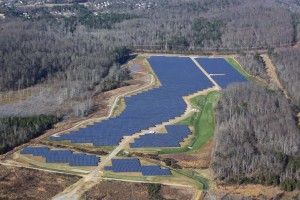With a little help from the sun, Volkswagen has fired up what it is calling the biggest solar power array in use at any American auto plant.
The Volkswagen Chattanooga Solar Park can produce a maximum 13.1 gigawatt-hours of electricity annually, enough to power 1,200 typical homes – or about 12.5% of the energy needs of the sprawling complex where the maker assembles its midsize Passat model.
“The solar park is another proof point of Volkswagen’s worldwide commitment to environmental protection under its Think Blue factory philosophy,” said Frank Fischer, CEO and Chairman of VW’s Chattanooga manufacturing operations, “a broadly focused initiative for all Volkswagen plants to achieve more efficient use of energy, materials and water and produce less waste and emissions.”
The maker has been adding solar arrays at a number of its plants around the world, including an 80,000 square-foot array covering the roofs of Audi assembly lines in Ingollstadt and Neckarsulm, Germany. But the new complex dwarfs those, at 33 acres, the complex containing 33,600 individual solar modules.
When the 1.9 million square-foot plant is not in production, the Solar Park can provide 100% of its electrical needs.
The project “symbolizes the beginning of a new era in manufacturing operations,” proclaimed Matthew Kisber, President and CEO of Silicon Ranch, which developed and operates the solar array.
When the Chattanooga plant was opened in late 2011, it earned a LEED Platinum certification from the U.S. Green Building Council – which declared the factory “the world’s greenest auto plant.”
It remains the only auto plant in the world with that level of certification. But a number of other makers have been chasing that target. General Motors has been setting up a number of solar arrays at its manufacturing centers, as well, including one at the Detroit-Hamtramck Assembly Plant where it produces its Chevrolet Volt plug-in hybrid. Among other things, the panels are used to charge up the batteries on the vehicles before they are shipped to dealers.


This illustrates how much money VW is making in profits as solar is far from efficient, though it’s nice to be “green” – when someone else is paying for it.